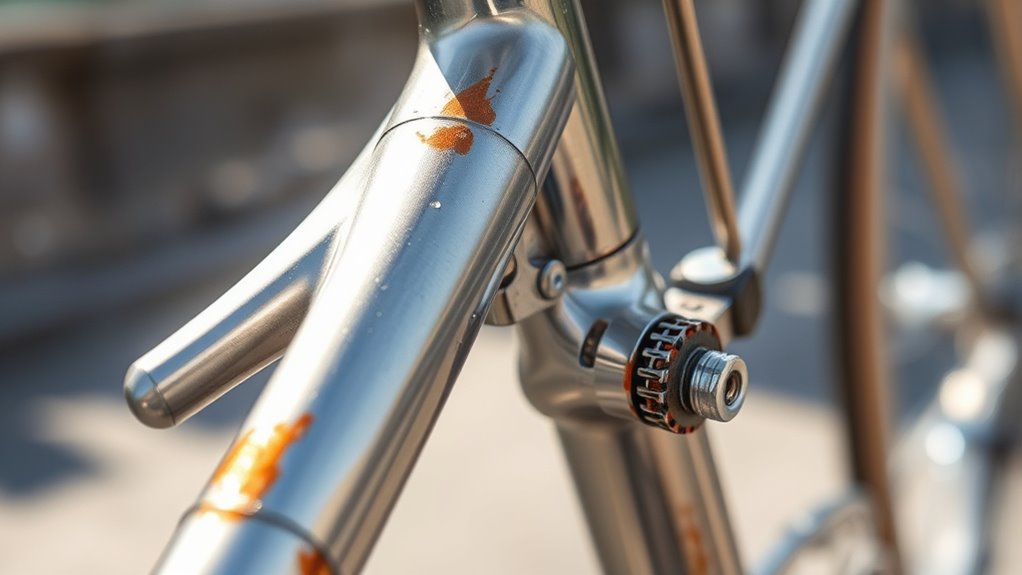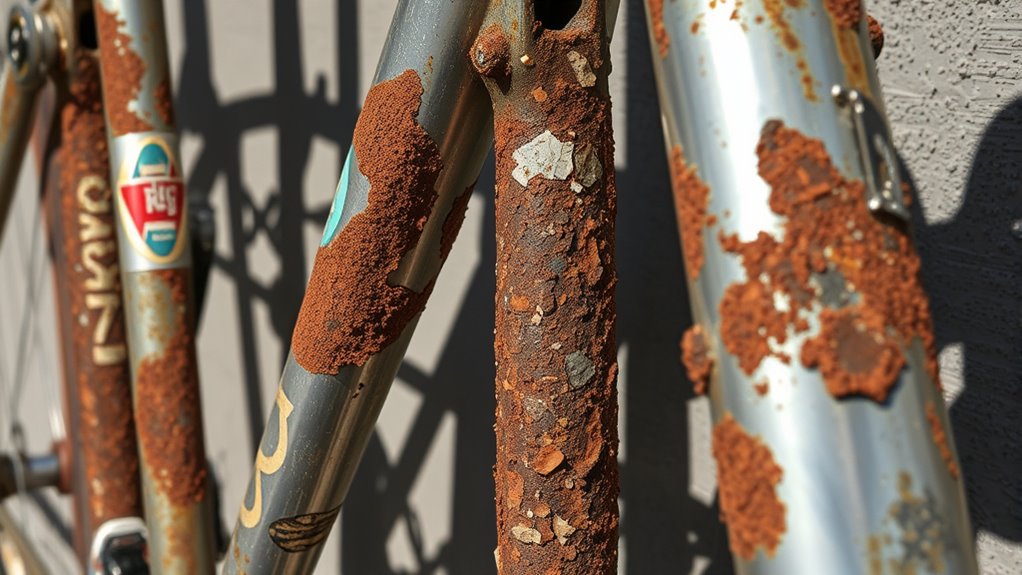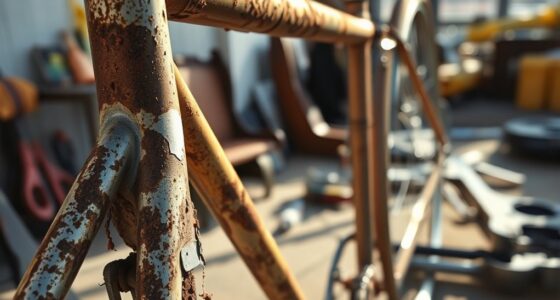Stainless steel bikes are highly resistant to rust and corrosion, making them a durable choice for outdoor use. You’ll find that they can handle rain, mud, and salt without deteriorating like other metals. Their surface naturally resists oxidation, so your bike stays shiny and intact over time. This means less maintenance and worry about rust issues. Keep going for more details on how stainless steel can keep your bike lasting longer than you might expect.
Key Takeaways
- Stainless steel naturally resists rust, making it highly durable for bike frames and components.
- Its corrosion resistance remains effective even when exposed to rain, mud, and salt.
- Unlike other metals, stainless steel doesn’t require protective coatings to prevent rust.
- Proper maintenance extends stainless steel’s appearance, but it is inherently resistant to oxidation.
- While highly resistant, extreme conditions or damage can still cause minimal corrosion over time.

Stainless steel has become a popular choice for bike frames and components because it offers durability, corrosion resistance, and a sleek appearance. When you choose stainless steel, you’re opting for a material that can stand up to the elements and frequent use. Its inherent corrosion prevention qualities mean your bike is less likely to rust over time, even when exposed to rain, mud, or salt. This makes stainless steel an excellent option if you ride regularly in diverse conditions or store your bike outdoors. Unlike other metals that require constant maintenance or protective coatings, stainless steel naturally resists oxidation, which helps maintain its shine and integrity over years of use. Additionally, the high tensile strength of stainless steel ensures your bike remains resilient under various stresses during rides. Material durability is one of the biggest selling points of stainless steel. You won’t have to worry about dents, cracks, or warping as easily as with some other materials. Its strength allows it to absorb shocks and impacts without losing structural integrity, keeping you safe during your rides. Whether you’re tackling rough terrains or maneuvering city streets, stainless steel frames stay resilient. This durability extends to the components too, such as handlebars, seat posts, and spokes, which can endure daily wear and tear without needing frequent replacements. By investing in stainless steel, you’re choosing a long-lasting option that can withstand the rigors of cycling and harsh environments.
Frequently Asked Questions
Can Stainless Steel Bike Parts Corrode Under Extreme Conditions?
Yes, stainless steel bike parts can corrode under extreme conditions. While they offer excellent corrosion resistance, intense environments like salty coastal air, high humidity, or extreme heat can challenge that resistance. You might notice signs of rust or discoloration if the stainless steel isn’t high-grade or if it’s exposed to prolonged harsh conditions. Regular maintenance and choosing the right stainless steel type can help protect your bike parts from corrosion.
How Does Stainless Steel Compare to Aluminum Regarding Weight?
Imagine choosing between two champions—stainless steel and aluminum. When it comes to weight comparison, aluminum is the lighter contender, making your ride feel effortless. Stainless steel, however, boasts greater material strength, offering durability without sacrificing too much weight. You gain strength with a slight increase in weight, but if you want a lightweight bike, aluminum’s your best bet. Both have their merits—your choice depends on what matters most for your ride.
Is Stainless Steel More Environmentally Friendly Than Other Materials?
Yes, stainless steel is more eco-friendly than many other materials. Its eco-friendly manufacturing process reduces environmental impact, and it offers significant recyclability benefits—over 90% of stainless steel can be recycled without losing quality. By choosing stainless steel, you help lower waste and energy consumption, making it a sustainable choice for bike parts and other applications. Its durability also means fewer replacements, further supporting environmental conservation.
Are There Specific Cleaning Products Recommended for Stainless Steel Bikes?
You should use a bike polish or stainless cleaner specifically designed for stainless steel to keep your bike looking its best. These products help remove dirt, fingerprints, and minor rust spots while protecting the surface. Avoid harsh abrasives or steel wool, which can scratch the finish. Regular cleaning with a gentle stainless cleaner and wiping down with a soft cloth will maintain your bike’s shine and durability over time.
How Long Does Stainless Steel Typically Last on a Bike?
You’ll find that stainless steel on your bike typically lasts 20-30 years if you maintain it properly. Its corrosion resistance helps prevent rust, but regular maintenance is key. Don’t worry—routine cleaning and occasional inspections can extend its lifespan considerably. While some think stainless steel is maintenance-free, staying consistent with cleaning ensures your bike stays corrosion-free and looks great for decades.
Conclusion
While stainless steel on bikes offers a charming hint of sophistication, it’s not entirely immune to life’s little imperfections. Over time, even the most resilient can show signs of wear, reminding you that nothing is truly flawless. Embrace these subtle changes as part of your bike’s unique story, adding character and depth. After all, it’s the gentle, unnoticed aging that gives your ride its quiet, enduring charm—an understated reminder that beauty often lies in the subtle imperfections.
















